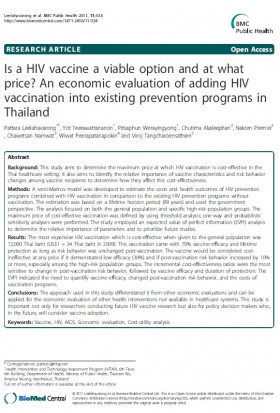This website uses cookies so that we can provide you with the best user experience possible. Cookie information is stored in your browser and performs functions such as recognising you when you return to our website and helping our team to understand which sections of the website you find most interesting and useful.
Is a HIV vaccine a viable option and at what price? An economic evaluation of adding HIV vaccination into existing prevention programs in Thailand.(2011)

รายละเอียดเพิ่มเติม
Is a HIV vaccine a viable option and at what price? An economic evaluation of adding HIV vaccination into existing prevention programs in Thailand
Pattara Leelahavarong1*, Yot Teerawattananon1, Pitsaphun Werayingyong1, Chutima Akaleephan2,
Nakorn Premsri3, Chawetsan Namwat3, Wiwat Peerapatanapokin4 and Viroj Tangcharoensathien2
1Health Intervention and Technology Assessment Program (HITAP)
Background
This study aims to determine the maximum price at which HIV vaccination is cost-effective in the Thai healthcare setting. It also aims to identify the relative importance of vaccine characteristics and risk behavior changes among vaccine recipients to determine how they affect this cost-effectiveness.
Methods
A semi-Markov model was developed to estimate the costs and health outcomes of HIV prevention programs combined with HIV vaccination in comparison to the existing HIV prevention programs without vaccination. The estimation was based on a lifetime horizon period (99 years) and used the government perspective. The analysis focused on both the general population and specific high-risk population groups. The maximum price of cost-effective vaccination was defined by using threshold analysis; one-way and probabilistic
sensitivity analyses were performed. The study employed an expected value of perfect information (EVPI) analysis to determine the relative importance of parameters and to prioritize future studies.
Results
The most expensive HIV vaccination which is cost-effective when given to the general population was 12,000 Thai baht (US$1 = 34 Thai baht in 2009). This vaccination came with 70% vaccine efficacy and lifetime protection as long as risk behavior was unchanged post-vaccination. The vaccine would be considered costineffective at any price if it demonstrated low efficacy (30%) and if post-vaccination risk behavior increased by 10% or more, especially among the high-risk population groups. The incremental cost-effectiveness ratios were the most sensitive to change in post-vaccination risk behavior, followed by vaccine efficacy and duration of protection. The EVPI indicated the need to quantify vaccine efficacy, changed post-vaccination risk behavior, and the costs of vaccination programs.
Conclusions
The approach used in this study differentiated it from other economic evaluations and can be applied for the economic evaluation of other health interventions not available in healthcare systems. This study is important not only for researchers conducting future HIV vaccine research but also for policy decision makers who, in the future, will consider vaccine adoption.
Keywords: Vaccine, HIV, AIDS, Economic evaluation, Cost-utility analysis




